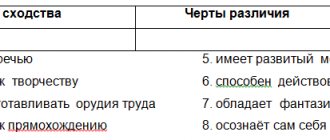Since ancient times, observing the sky, people have noticed that at different times of the same month the moon can have different shapes.
Sometimes the moon is round, sometimes it’s only half a circle, and sometimes it’s just a narrow stripe from the circle.
People thought that the moon was swallowed by an evil monster, and then a new moon was born and grew again to a whole circle. They even gave different names: a full moon is a moon, and a partial moon is a month.
Why does the moon come in different shapes?
Depending on what part of the moon the Sun illuminates, phases or quarters of the Moon are distinguished.
Moon phases are different parts of the visible Moon
1st phase (or 1st quarter) – new moon. The Moon is between the Earth and the Sun, the Moon is not visible in the sky. This phase is called the new moon.
Phase 2 (or 2nd quarter) - waxing Moon. The light of the sun hits the moon. At first, only a small piece of the Moon's circle in the sky is illuminated by the sun. The lunar disk looks like the letter “C” upside down.
This piece gradually grows and becomes like a sickle. The part of the lunar circle illuminated by the sun grows and the semicircle of the Moon becomes visible.
Phase 3 (or 3rd quarter) – full moon. The moon looks like a whole disk. Earth between the Sun and Moon.
4th phase (or 4th quarter) – decreasing. Surface
less lighting. The moon becomes a crescent again. The crescent moon in the sky looks like the letter “C”.
This is how the cycle ends. The four phases of the moon make up a lunar month - 29.5 days.
Who are astronomers
Astronomers are scientists who study celestial bodies.
Astronomers monitor the movements of planets, stars and other celestial bodies through a space telescope
A telescope is an optical instrument for observing distant objects, providing multiple magnification.
Orbital path of the Moon - explanation for children
Children should know that the moon's gravity affects our planet by causing sea levels to rise and fall (high and low tides). To a lesser, but still noticeable, extent, this is manifested in lakes, the atmosphere and the earth's crust.
The water rises and falls. On the side facing the Moon, the tide is stronger. But even on the second one it occurs by inertia, so low tides are created between these two points. The Moon also slows down the rotation of our planet (tidal braking). This increases the length of the day by 2.3 milliseconds each eyelid. The energy is absorbed by the Moon and increases the distance between us. That is, for the little ones it is important to learn that the satellite moves away by 3.8 cm every year.
View of the Earth from the surface of the Moon
Perhaps it was lunar gravity that caused the formation of the Earth as a planet suitable for life. It moderated fluctuations in axial tilt, allowing a stable climate to persist for billions of years. But the satellite did not stand aside, since the earth’s gravity once stretched it to incredible shapes.
Seas, mountains and craters on the moon
Observing the Moon through a telescope, scientists noticed dark and lighter spots
In the old days, it was thought that the darker spots on the surface of the Moon were seas. People thought that there was water on the Moon, just like on Earth. It is now known that there are no seas or water on the Moon. But the old names remained on the map of the Moon - the Sea of Clouds, the Sea of Rains and other seas.
Craters on the Moon
The light areas of the surface are lunar mountains, their height is up to several thousand meters.
There are lunar craters everywhere on the Moon. These are pits formed by the impacts of meteorites - rocks that fell from space. The edges of the craters are surrounded by high hills.
Why is the Moon different? presentation for a lesson on the world around us (grade 1) on the topic
Slide 1
Why is the Moon different? Textbook: The world around us. 1 class. Pleshakov A.A. Teacher: Antipova I.I. Moscow, 2016
Slide 2
Why is the Moon different?
Slide 4
The cycle of lunar phases begins with the young Moon. This happens when the Moon is between the Earth and the Sun. The new moon is not visible. Then the side of the Moon facing the Earth begins to be illuminated by the Sun. The illuminated part looks like a thin, narrow piece of a circle. It is called the waxing moon.
Slide 5
The solar part of the Moon grows rapidly and reaches a semicircle. This is called the first quarter. Then the surface of the Moon becomes less and less illuminated and reaches the last quarter. Thus the cycle ends and is replaced by a new, young, growing Moon. The full cycle from one new moon to the next takes 29.5 days.
Slide 6
The Moon itself does not emit light; it, like a mirror, reflects the light of the Sun. The Secret of the Moon. How it shines...
Slide 7
What is a satellite? A satellite is a celestial body that moves around a larger body. Natural satellites of planets are their natural satellites, that is, those that were not created by man.
Slide 8
The Earth is 6 times larger than the Moon. The Moon is a satellite of the Earth. Compare the sizes of the Earth and the Moon.
Slide 9
Rotation of the Moon around the Earth. The Moon moves around the Earth and circles it once a month.
Slide 10
The Earth is separated from the Moon by a distance of 384,000 kilometers. On a space rocket this distance can be covered in 2-3 days.
Slide 11
How do scientists study the Moon?
Slide 12
There are dark and light spots on the Moon. The light spots are the lunar seas, but there is no water in them. Dark spots are smooth areas. Lunar craters are visible on the Moon. They were formed from the impacts of meteorites - rocks that fell from space. What do we see on the surface of the Moon when looking through a telescope?
Slide 13
Lunar seas. In the old days, people considered grayish spots on the Moon to be seas. There is not a drop of water in these “seas”. The lunar “seas” are deep depressions covered with frozen volcanic mass. The color of this mass is darker than the surrounding stones, so it is clearly visible from Earth. Although scientists now know that there are no seas on the Moon, they decided not to change the names on the map of this planet.
Slide 14
Therefore, there you can find the Ocean of Storms, the Sea of Clouds, the Sea of Rains and many other seas.
Slide 15
Mountainous regions of the Moon. The bright parts of the Moon are its mountainous regions. The Moon has high mountain ranges and many ring mountains called craters. Craters are large pits surrounded by hills. Some of these craters were formed when meteorites fell on the Moon. The largest craters were formed during volcanic eruptions.
Slide 16
Lunokhod. An automatic device controlled from the Earth by radio, which was sent to the Moon.
Slide 17
Why don't people live on the moon? There is no air on the moon. There is no grass or trees here either. There is nothing but dust and stone desert all around.
Slide 18
The day lasts for two weeks, then the night lasts for two weeks. During such a long day, the surface of the Moon manages to heat up to a temperature of + 130 degrees. When night falls, the stones quickly cool and the frost reaches a temperature of 170 degrees.
Slide 19
1. If you want to jump, keep in mind that you will jump 6 times higher than on Earth, and you will fall much slower. The gravity on the Moon is 6 times less. 2. If you are walking, watch your step. The entire surface is strewn with stones that fall from space. 3. Don't forget to take a watch with a calendar. On the Moon, one of our days lasts 2 of our weeks. 4. You won’t need an umbrella: it doesn’t rain on the Moon. There is no water at all, no clouds, fogs or rainbows. The only rains are meteorites and rocks. 5. Don’t forget that you can only talk using Radio Transmitters. There are no sounds on the Moon. This is because there is no atmosphere. 6. Think about how you will breathe? After all, there is no air on the Moon. 7. Think about how you should dress, since during the day the surface of the Moon heats up to +130 degrees, and at night it cools down to -170 degrees. Some advice for those flying to the moon
Slide 20
Thank you for your attention!!
Moon phases 2020 by month and day
A person lives his entire earthly life in constant contact with such celestial bodies as the Sun and Moon. The first refers to the concept of “star”, the second – a planet that is a satellite of the Earth.
And no matter how people wish it, both the Sun and the Moon influence the internal state, physical health and other processes that occur within the Blue Planet.
How to track the cycles and phases of the Moon (by month and day), and anticipate favorable days in 2020? Read about this in this article.
Characteristic features of the Moon
The name itself means “light” in translation. It is known that the satellite rotates around the Earth in an orbit that is not round, but oval. The period is approximately 27.3 days (therefore the lunar calendar consists of 29 days).
It is known that the satellite is gradually moving away from the blue planet (by 4 centimeters per year), and therefore the orbit of the Moon is a successively unwinding spiral.
The structure of the celestial body consists of a core and three layers of mantle. The outer surface consists of loose lunar soil - regolith. It has low reflectivity. In color, the Moon seems almost monochromatic, yellowish, with barely visible spots.
But there are periods when it takes on an ashy hue.
Significance for planet Earth
Thanks to the Moon, people were able to learn to determine a new week or the beginning of a new month (just as with the help of the Sun they could celebrate a new year).
Each of these indicators forms the basis of the lunar calendar, which is compiled to understand the movement of the celestial bodies. For example, moon phases by month in 2020.
The influence of the Earth's satellite on the life and health (mental and physical) of a person has long been noticed by observant people.
About the phases of the moon
People from Earth can only see the part of the Moon's surface illuminated by the Sun, which revolves around the Blue Planet. There are days when its thin curved stripe is visible - a “sickle” (new moon), and there is a bright circle (full moon).
It is this sequential change in the visible parts of the surface of the Moon that is called the cycle of lunar phases. There are four of them (main) and the same number of intermediate states - depending on the location of the satellite from the Earth.
The lunar calendar consists of 29 days. And the Earth’s satellite goes through each phase in 7 days (that’s why there are the same number of days in a week!).
The phases have their own name, and each of them is characterized by its own characteristics, which are also manifested in the states of people and the implementation of life processes:
- New moon.
- First lunar phase.
- First quarter – second phase.
- Full moon.
- Third phase.
- Waning moon.
- Fourth phase.
- Old Moon.
Description of each phase
- It is typical for the new moon that the celestial body itself is not yet visible, but some people’s health deteriorates somewhat on such days, and apathy and irritability may be felt. During this period, it is not recommended to start new and important things.
- The first lunar phase is characterized by the fact that it is already visible and is visible from the Earth as a “sickle”. This period is favorable for new projects (in the field of business, creativity, sports), as well as doing household chores.
- The second phase allows you to already see half of the Moon, but for a person this period is fraught with the possibility of getting sick or overtired.
- During the full moon, the Earth's satellite reflects sunlight most brightly and already looks like a luminous circle. People feel a surge of energy (including emotional energy), a readiness to complete complex tasks, and accomplish many things with ease.
- In the third phase, the Moon again decreases in size and declines. If a person has previously accumulated a sufficient amount of positive energy, then during this period he will feel normal.
- During the waning Moon, it is recommended to devote time to your health and appearance.
- When the fourth lunar phase begins, a thin “sickle” is again visible from the Earth. The time is suitable for thinking about life, putting in order not only the internal world, but also the external one (cleaning, getting rid of trash, and so on).
- When the Moon becomes old, a person may feel a decline in energy in himself, which is accompanied by apathy, sensitivity to the words and actions of other people.
Other phenomena involving the Moon
A supermoon occurs when the Moon comes closest to the Earth and appears brighter and larger. This phenomenon occurs during the new moon and full moon.
An eclipse is an unusual phenomenon during which the Moon appears in a cone of shadow cast by the Blue Planet. And if the satellite is completely placed in this shadow, the eclipse is called total, if only part of it is called partial.
These phenomena will also occur in 2020: 2 supermoons and the same number of lunar eclipses.
Calendar for 2020
Since there are four main lunar phases, the calendar is built according to the days and times of the beginning of each of them: new moon, waxing moon, full moon, waning moon.
In 2020, the phases of the moon by day are as follows.
In January:
- 1st - waxing moon;
- full moon - 2nd;
- waning moon - January 3-16;
- the new moon will be on January 17;
- waxing moon - January 18-30;
- full moon - January 31st.
Also on January 2, at 5.24, there is a supermoon, and on January 31, 2018, at 13.51, there is a lunar eclipse.
In February:
- waning moon - February 1-15;
- new moon - 16th;
- waxing moon - February 17-28.
In March:
- 1st - waxing moon;
- full moon - 2nd;
- waning moon - March 3-16;
- new moon - March 17;
- waxing moon - March 18-30;
- full moon - March 31st.
In April:
- waning moon - April 1-15;
- new moon - 16th;
- waxing moon - April 17-29;
- full moon - April 30.
In May:
- waning moon - May 1-14;
- new moon - 15th;
- waxing moon - May 16-28;
- full moon - May 29;
- waning moon - May 30-31.
In June:
- waning moon - June 1-12;
- new moon - 13th;
- waxing moon - June 14-27;
- the full moon will be on June 28;
- waning moon - June 29-30.
In July:
- waning moon - July 1-12;
- the new moon will be on the 13th;
- waxing moon - July 14-26;
- the full moon will be on July 27;
- waning moon - July 28-31.
Also on July 13, 2020, at 5.47, there is a supermoon, and on the 27th, at 23.22, there is a lunar eclipse.
In August:
- waning moon - August 1-10;
- new moon - 11th;
- waxing moon - August 12-25;
- the full moon will be on the 26th;
- waning moon - August 27-31.
In September:
- waning moon - September 1-8;
- new moon - 9th;
- waxing moon - September 10-24;
- full moon - 25th;
- waning moon - September 26-30.
In October:
- waning moon - October 1-8;
- new moon - 9th;
- waxing moon - October 10-23;
- full moon - 24th;
- waning moon - from the 25th to the 31st.
In November:
- waning moon - November 1-6;
- new moon - 7th;
- waxing moon - November 8-22;
- full moon - 23rd;
- waning moon - November 24-30.
December:
- waning moon - December 1-6;
- new moon - 7th;
- waxing moon - December 8-21;
- full moon - 22nd;
- waning moon - December 23-31.
Favorable days of the lunar calendar
Every month of the year has good and bad days. First of all, this is again due to the phases of the satellite.
For example, the first quarter after the new moon is considered a favorable phase of the moon. These days it is recommended to start new projects, establish relationships with people, and so on. Most of all, you feel full of energy and good concentration.
Also successful are periods when an aspect of 60 and 120 degrees is created between the celestial bodies - the Moon and the Sun.
All this information can be clarified in the sections on the phases of the moon by month for the year.
fb.ru
Completing page 3.
Task 2.
The moon is not always completely visible in the sky. Often we see only part of it. The one that is illuminated by the Sun at this moment.
Observe the Moon for a month (once a week). Draw what the Moon will look like. With the help of an adult, write down the day and month of each observation.
Completion: For a month, once a week, we observe the Moon and sketch in our diary the shape that we see.
Observations should begin two to three days after the new moon, when a tiny crescent moon appears in the sky. The horns of the sickle will be turned to the left, the Moon is growing.
In a week, the Moon will also grow, but the crescent shape will be almost round.
In another week the Moon will be waning, it will be almost round, but a slight unevenness will be noticeable on the right side.
And in the last week the sickle will become narrow again, but its horns will be turned to the right. The moon is waning.






